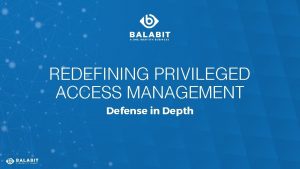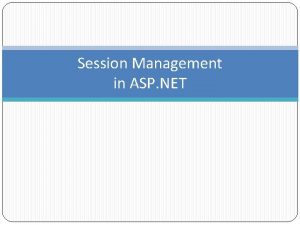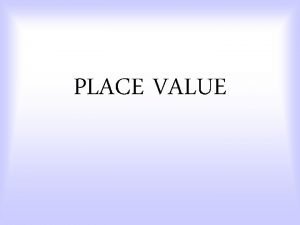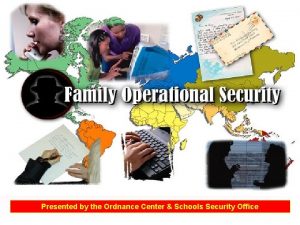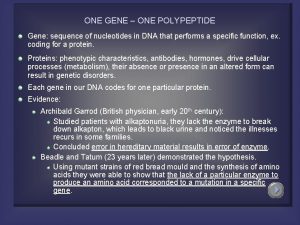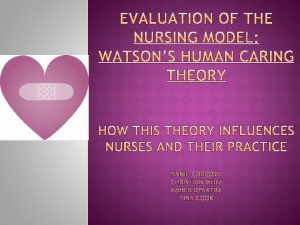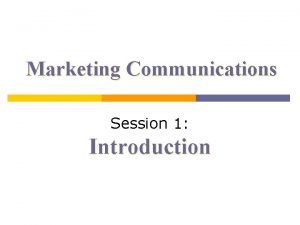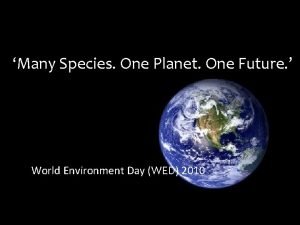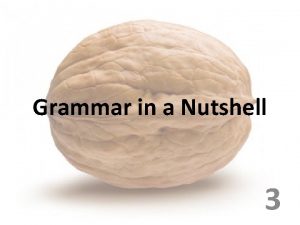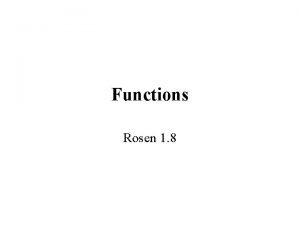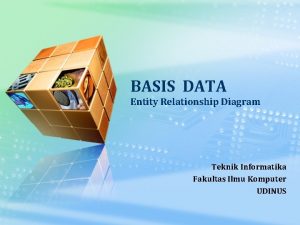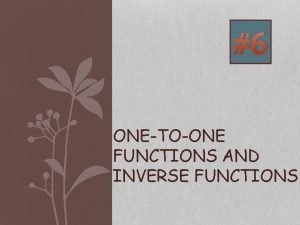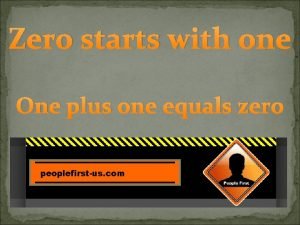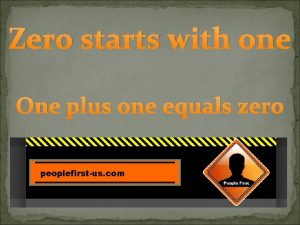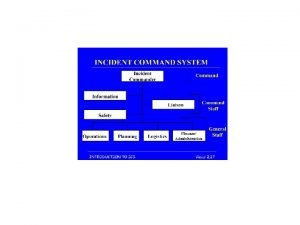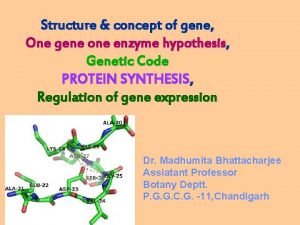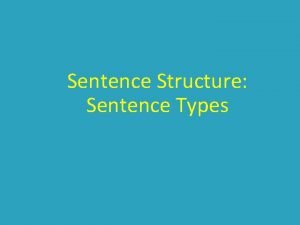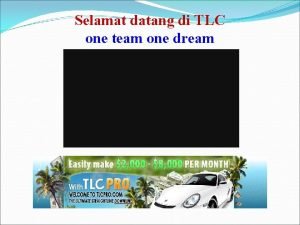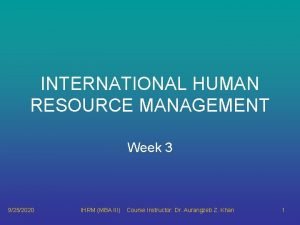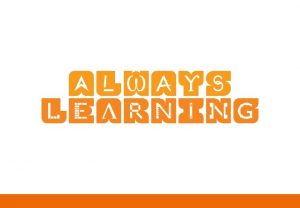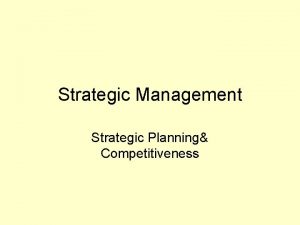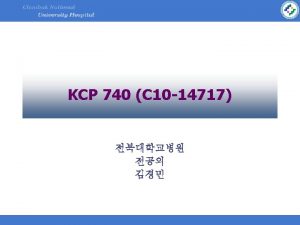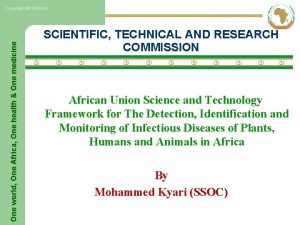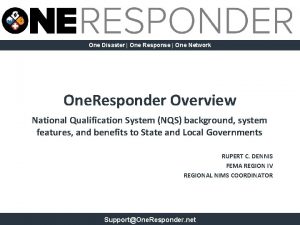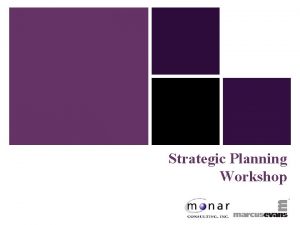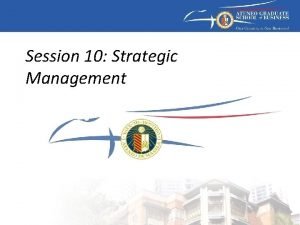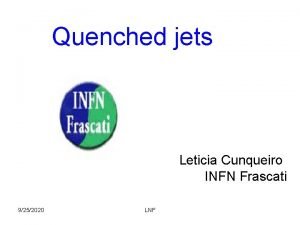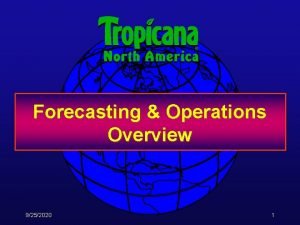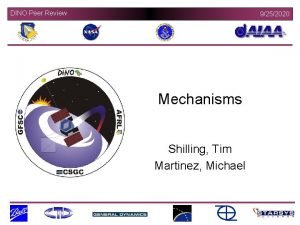Strategic Management Session One 9252020 Strategic Management Session



















![The Resource-Based Model of AAR (Cont’d) • Basic Premise - a firm's unique [internal] The Resource-Based Model of AAR (Cont’d) • Basic Premise - a firm's unique [internal]](https://slidetodoc.com/presentation_image/686f1f2ae869a39f8186c322e95f8c52/image-20.jpg)
















- Slides: 36

Strategic Management Session - One 9/25/2020 Strategic Management -Session One 1

Nature of Competition: Boeing vs. Airbus • Boeing – Historically a global leader in airplane manufacturing – Revenue from commercial aircraft division & gov’t contracts – Regained supremacy in 2006: more 787 super jumbo orders vs. Airbus’s more efficient A-380 – Changed strategy and design • Different production process • Smaller plane (787 Dreamliner) • Airbus – EU Government owned and subsidized – Won competitor battle with Boeing between 2001 & 2005 – Responded to customer demands with more efficient A-380 aircraft 9/25/2020 Strategic Management -Session One 2

Nature of Competition: Basic concepts • Strategic Competitiveness – Achieved when a firm formulate & implements a value-creating strategy • Strategy – Integrated and coordinated set of commitments and actions designed to exploit core competencies and gain a competitive advantage 9/25/2020 Strategic Management -Session One 3

Nature of Competition: Basic concepts • Competitive Advantage (CA) – Implemented strategy that competitors are unable to duplicate or find too costly to imitate • Above Average Returns – Returns in excess of what investor expects in comparison to other investments with similar risk 9/25/2020 Strategic Management -Session One 4

Nature of Competition: Basic concepts • Risk – Investor’s uncertainty about economic gains/losses resulting from a particular investment • Average Returns – Returns equal to what investor expects in comparison to other investments with similar risk • Strategic Management Process (SMP) – Full set of commitments, decisions and actions required for a firm to achieve strategic competitiveness and earn above average returns 9/25/2020 Strategic Management -Session One 5

Stakeholders • Basic Premise – a firm can effectively manage stakeholder relationships to create a competitive advantage and outperform its competitors • Stakeholders are individuals and groups – They can affect, and are affected by, the strategic outcomes/performance a firm achieves – Three (3) classifications 9/25/2020 Strategic Management -Session One 6

The Three Stakeholder Groups 9/25/2020 Strategic Management -Session One 7

Stakeholders (Cont’d) • Classifications of Stakeholders – Capital Market • Expect returns commiserate with risk accepted by investments • Higher the dependency relationship, the more direct and significant firm’s response – Product Market • The 4 groups benefit due to competitive battles – Organizational • The employees- Managers, Non Managers 9/25/2020 Strategic Management -Session One 8

21 st Century Competitive Landscape • Introduction: The Competitive Landscape (CL) – Pace of change is rapid – Partnerships created by mergers & acquisitions (M&As) – Other CL characteristics: Economies of scale, advertising budgets not as effective as before, change in managerial mind-set from “traditional” to more flexible and innovative 9/25/2020 Strategic Management -Session One 9

21 st Century Competitive Landscape • Introduction: The Competitive Landscape (CL) – Hypercompetition – extremely intense rivalry among competing firms, characterized by • Escalating & increasingly aggressive competitive moves • Assumptions of market stability replaced with notion of Instability and change – Two primary drivers of the competitive landscape: • The global economy • Technology 9/25/2020 Strategic Management -Session One 10

21 st Century Competitive Landscape (Cont’d) • The Global Economy – Goods, services, people, skills and ideas move freely across geographic borders – Europe, through the European Union (EU) is the world’s largest single market • EU vs U. S. GDP: 35% higher – Emerging major competitive forces: China & India – In summary: globalization increased economic interdependence among countries as reflected in the flow of goods and services, financial capital, and knowledge across country borders 9/25/2020 Strategic Management -Session One 11

21 st Century Competitive Landscape (Cont’d) • Technology and Technological Changes – 3 categories: • 1. Technology diffusion & disruptive technologies • 2. The information age • 3. Increasing knowledge intensity 9/25/2020 Strategic Management -Session One 12

Industrial Organizational (I/O) Model of Above-Average Returns (AAR) 9/25/2020 Strategic Management -Session One 13

Industrial Organizational (I/O) Model of Above-Average Returns (AAR) • Basic Premise – to explain the dominant influence of the external environment on a firm's strategic actions and performance 9/25/2020 Strategic Management -Session One 14

Industrial Organizational (I/O) Model of Above-Average Returns (AAR) • Underlying Assumptions – External environment imposes pressures and constraints that determine the strategies resulting in AAR – Most firms compete within a particular industry/segment • Control similar strategically relevant resources • Pursue similar strategies in light of those resources 9/25/2020 Strategic Management -Session One 15

Industrial Organizational (I/O) Model of Above-Average Returns (AAR) • Underlying Assumptions – Resources for implementing strategies are highly mobile across firms • Therefore any resource differences between firms will be short-lived – Organizational decision makers are rational and committed to acting in the firm's best interests, as shown by their profit-maximizing behaviors 9/25/2020 Strategic Management -Session One 16

Industrial Organizational (I/O) Model of Above-Average Returns (AAR) • Five-Forces Model (Michael Porter) – The 5 Forces includes • Suppliers, buyers, competitive rivalry, product substitutes and potential entrants – Reinforces the importance of economic theory – Analytical tool previously lacking in the field of strategy – Determines the nature/level of competition and profit potential in an industry • 9/25/2020 Suggests an industry’s profitability is an interaction between these 5 forces Strategic Management -Session One 17

Industrial Organizational (I/O) Model of Above-Average Returns (AAR) (Cont’d) • Limitations – Only two strategies are suggested: • Cost Leadership – THE low-cost leader • Differentiation – Customer willing to pay the premium price for ‘being different’ – Internal resources & capabilities not considered 9/25/2020 Strategic Management -Session One 18

The Resource. Based Model of AAR 9/25/2020 Strategic Management -Session One 19
![The ResourceBased Model of AAR Contd Basic Premise a firms unique internal The Resource-Based Model of AAR (Cont’d) • Basic Premise - a firm's unique [internal]](https://slidetodoc.com/presentation_image/686f1f2ae869a39f8186c322e95f8c52/image-20.jpg)
The Resource-Based Model of AAR (Cont’d) • Basic Premise - a firm's unique [internal] resources & capabilities, in combination, is the basis for firm strategy and AAR – Each firm’s performance difference across time emerges (vs industry’s structural characteristics) – Combined uniqueness should define the firms’ strategic actions – Resources are tangible and intangible 9/25/2020 Strategic Management -Session One 20

The Resource-Based Model of AAR (Cont’d) • Resources – Inputs into a firm's production process • Includes capital equipment, employee skills, patents, high-quality managers, financial condition, etc. – Basis for competitive advantage: When resources are valuable, rare, costly to imitate and nonsubsitutable 9/25/2020 Strategic Management -Session One 21

The Resource-Based Model of AAR – Resources • Internal/firm-specific resources (N=3) • Physical – Things you can touch/feel = tangible • Human – People / employees • Organizational capital – Relative to the firm itself 9/25/2020 Strategic Management -Session One 22

The Resource-Based Model of AAR (Cont’d) • Capability – Capacity for a set of resources to perform a task or activity in an integrative manner • Core Competency – A firm’s resources and capabilities that serve as sources of competitive advantage over its rival • Summary – A firm has superior performance because of • Unique resources and capabilities, and the combination makes them different, and better, than their competition – driving the competitive advantage 9/25/2020 Strategic Management -Session One 23

Vision and Mission • Vision – Picture of what the firm wants to be – What the firm ultimately wants to achieve – An effective vision statement is the responsibility of the leader who should work with others to form it – Foundation for the mission • Mission – Specifics business(es) in which firm intends to compete and customers it intends to serve – More specific than the vision 9/25/2020 Strategic Management -Session One 24

9/25/2020 Strategic Management -Session One 25

What Makes a Successful Strategy? Successful � strategy EFFECTIVE IMPLEMENTATION Long-term, simple and agreed objectives © 2010 Robert M. Grant www. contemporarystrategyanalysis. com Profound understanding of the competitive environment Objective appraisal of resources 26

9/25/2020 Strategic Management -Session One 27

The Basic Framework Strategy: the Link between the Firm and its Environment THE FIRM THE INDUSTRY ENVIRONMENT • Goals & Values • Resources & Capabilities • Structure & Systems © 2010 Robert M. Grant www. contemporarystrategyanalysis. com STRATEGY • Competitors • Customers • Suppliers 28

9/25/2020 Strategic Management -Session One 29

What is Strategy? • Distinguishing strategy from tactics: – Strategy is the overall plan for deploying resources to establish a favorable position. – Tactic is a scheme for a specific maneuver. • Characteristics of strategic decisions: – Important. – Involve a significant commitment of resources. – Not easily reversible. © 2010 Robert M. Grant www. contemporarystrategyanalysis. com 30

9/25/2020 Strategic Management -Session One 31

Describing Strategy: Competing for the Present; Preparing for the Future. STATIC DYNAMIC • • What do we want to become? - Vision statement • What do we want to achieve? - Mission statement - Performance goals • How will we get there? - Guidelines for development - Priorities for capital expenditure, R&D - Growth modes: organic growth, M&A, alliances • Where are we competing? - Product market scope - Geographical scope - Vertical scope How are we competing? - What is the basis of our competitive advantage? ) COMPETING FOR THE PRESENT © 2010 Robert M. Grant www. contemporarystrategyanalysis. com PREPARING FOR THE FUTURE 32

9/25/2020 Strategic Management -Session One 33

9/25/2020 Strategic Management -Session One 34

9/25/2020 Strategic Management -Session One 35

9/25/2020 Strategic Management -Session One 36
 Strategic competitiveness
Strategic competitiveness Analysing the 6 strategic options megxit
Analysing the 6 strategic options megxit One empire one god one emperor
One empire one god one emperor One one one little puppy run
One one one little puppy run One king one law one faith
One king one law one faith One god one empire one emperor
One god one empire one emperor One team one plan one goal
One team one plan one goal See one do one teach one
See one do one teach one One price policy
One price policy One face one voice one habit and two persons
One face one voice one habit and two persons See one do one teach one
See one do one teach one Asean tourism strategic plan
Asean tourism strategic plan One vision one identity one community
One vision one identity one community Strategic fit vs strategic intent
Strategic fit vs strategic intent Complements and substitutes
Complements and substitutes Privileged identity management
Privileged identity management Session tracking in asp.net
Session tracking in asp.net By one man sin
By one man sin You are my kryptonite figurative language
You are my kryptonite figurative language How many ones in 40
How many ones in 40 Othello scene 1 act 1
Othello scene 1 act 1 One team, one mission meaning
One team, one mission meaning One goal one passion
One goal one passion One gene one polypeptide concept
One gene one polypeptide concept Jean watson caring moment
Jean watson caring moment One voice one look
One voice one look Many species one planet one future
Many species one planet one future One ones are one
One ones are one What is one one and onto function
What is one one and onto function Erd film
Erd film Are cubic functions one to one
Are cubic functions one to one One plus one equals zero
One plus one equals zero One plus one equals zero
One plus one equals zero Texas rangers motto
Texas rangers motto One gene one enzyme
One gene one enzyme A simple sentence has one subject and one predicate
A simple sentence has one subject and one predicate One team one dream artinya
One team one dream artinya















